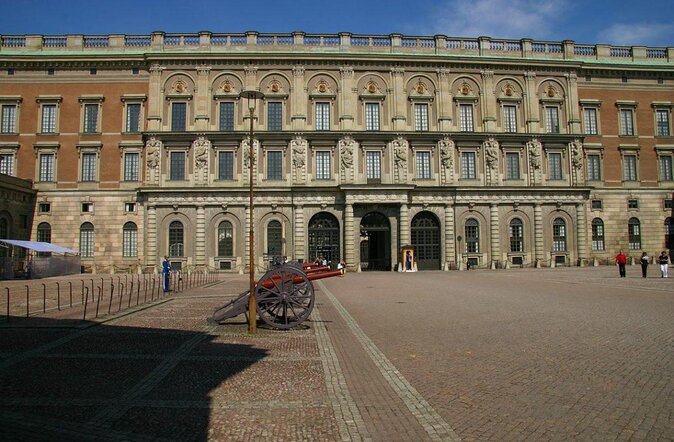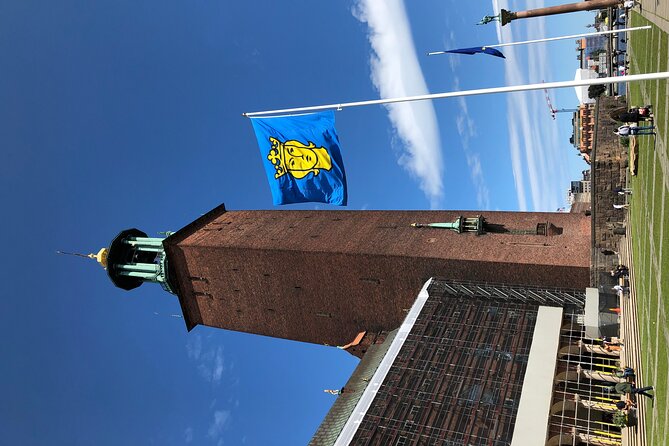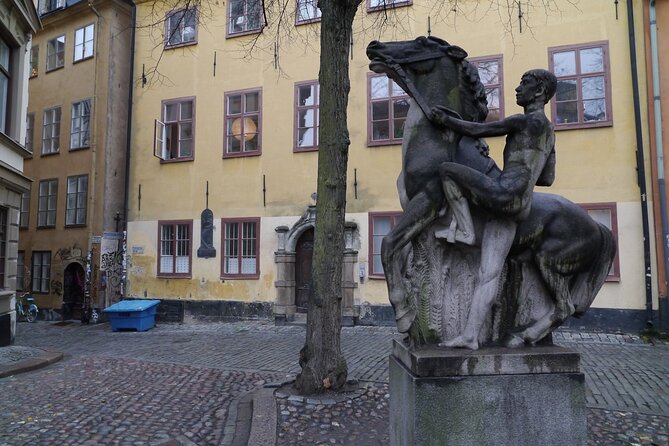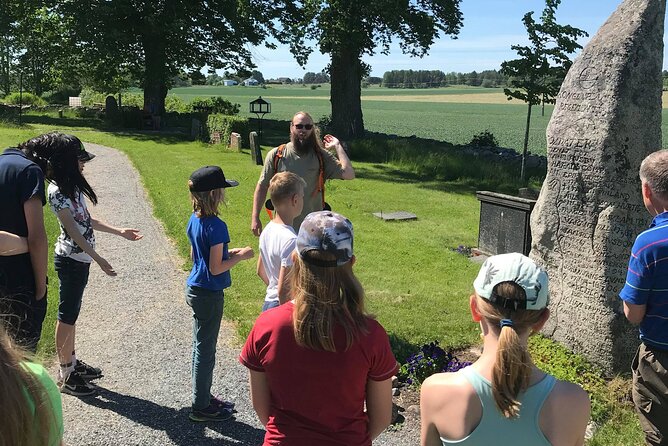Nestled on 14 islands connected by 57 bridges, Stockholm, the capital of Sweden, paints a captivating portrait of a city with a dramatic history. Like the ebb and flow of the Baltic Sea that surrounds it, Stockholm has weathered centuries of triumphs and tragedies, shaping its identity into a tapestry of resilience and transformation.
From its Viking origins to its modern-day allure, the city’s journey is one that begs exploration, unveiling tales of power, bloodshed, and grandeur. Step into the cobbled streets of Gamla Stan or wander the halls of the Royal Palace, and you’ll find yourself immersed in a world of intrigue and enchantment.
But the story of Stockholm is far from over; it continues to evolve, leaving visitors and locals alike yearning to unravel its secrets.
This experience made our list of the 20 Best Historical Tours In Stockholm.
Good To Know

- Stockholm is the capital of Sweden and is built on 14 islands connected by 57 bridges.
- The city is known for its beautiful architecture, waterfront views, and rich history dating back to the 13th century.
- Stockholm is home to cultural attractions such as museums and historic sites, including the Nobel Prize Museum.
- The tour covers the main highlights of Stockholm’s history and includes a visit to Stortorget, the oldest square in the city.
Viking Origins and Medieval Beginnings

Viking origins and medieval beginnings set the stage for the captivating history of Stockholm, the capital city of Sweden. The city’s history can be traced back to the Viking Age, when it was an important trading hub for the Norse people. The influences of the Vikings can still be seen today in Stockholm’s architecture and cultural heritage.
The medieval period brought further development and expansion to the city, with the construction of impressive buildings and fortifications. Stockholm’s architectural heritage is a testament to its rich history, with grand palaces, churches, and historic houses adorning the cityscape. Walking through the narrow streets of Gamla Stan, the old town, feels like stepping back in time to the Middle Ages.
The Viking origins and medieval beginnings of Stockholm have left an indelible mark on the city, making it a fascinating destination for history enthusiasts.
Interested in history? More Stockholm historical sites we've covered
The Stockholm Bloodbath and the Danish Rule

After the medieval period of development and expansion, Stockholm’s captivating history took a dark turn with the infamous Stockholm Bloodbath, marking the beginning of Danish rule over the city.
The Stockholm Bloodbath occurred in 1520 when King Christian II of Denmark invaded Stockholm to assert his authority over Sweden. The event was characterized by a brutal massacre of Swedish nobles and supporters of the Swedish independence movement.
The political repercussions of the bloodbath were significant, as it sparked widespread rebellion against Danish rule and ultimately led to the Swedish War of Liberation.
The Stockholm Bloodbath remains a pivotal moment in Stockholm’s history, symbolizing the struggle for independence and the resilience of the Swedish people. It serves as a reminder of the city’s enduring spirit and determination to preserve its autonomy.
Swedish Empire and the Great Power Era

During the Swedish Empire and the Great Power Era, Stockholm emerged as a dominant force in Europe, showcasing its military might and expanding its influence across the continent.
The Swedish Empire experienced significant expansion during this time, with Stockholm at its center. The city became an important hub for trade, as well as a strategic military stronghold.
One of the key factors in the rise of the Swedish Empire was the development of a powerful navy. The Swedish navy, known for its advanced warships and skilled sailors, played a crucial role in the empire’s expansion and dominance.
Stockholm’s strategic location on the Baltic Sea allowed for easy access to trade routes and provided a strong base for naval operations. The rise of the Swedish navy and the empire’s expansion solidified Stockholm’s position as a major player in European politics and economics.
18th and 19th Century Reforms and Modernization
The 18th and 19th centuries in Stockholm marked a period of significant reforms and modernization, propelling the city into a new era of progress and development. Industrialization played a central role in transforming Stockholm into a bustling hub of commerce and innovation. As factories and industries sprouted across the city, it led to an influx of people seeking employment opportunities. This rapid urbanization necessitated social reforms to address the challenges of overcrowding, poor living conditions, and labor exploitation. The city government implemented measures to improve public health, such as building sanitation systems and establishing hospitals. Education and welfare reform were also prioritized, providing citizens with access to education and social support. These reforms laid the foundation for Stockholm’s future as a modern, inclusive, and prosperous city.
| Industrialization | Social Reforms |
|---|---|
| Factories | Public health |
| Employment | Education |
| Urbanization | Welfare reform |
Note: The table provides a visual representation of the ideas discussed in the text, highlighting the key concepts of industrialization and social reforms.
20th Century Transformations and Contemporary Stockholm
Stockholm in the 20th century witnessed transformative changes that propelled it into the contemporary era, shaping the city into a vibrant and cosmopolitan metropolis.
One of the most notable aspects of this transformation was the development of Stockholm’s architectural wonders. Modern skyscrapers, such as the iconic Ericsson Globe Arena and Kista Science Tower, now dominate the city’s skyline, reflecting its status as a global hub for innovation and technology.
Plus, Stockholm experienced a cultural renaissance during this period, with the rise of renowned institutions like the Museum of Modern Art and the Royal Swedish Opera.
Today, the city continues to attract visitors with its dynamic blend of historic charm and modern sophistication, making it a must-visit destination for anyone seeking a glimpse into the contemporary face of Stockholm.
Common Questions
What Is the Significance of the 57 Bridges Connecting the 14 Islands of Stockholm?
The 57 bridges connecting the 14 islands of Stockholm hold great significance in the city’s history. They not only provide essential transportation links but also showcase the impressive engineering feats and unique charm of Stockholm’s island layout.
How Long Is the Tour of Stockholm’s Main Highlights?
The tour of Stockholm’s main attractions typically lasts around three hours. Participants will have the opportunity to visit iconic sites and landmarks, such as the Nobel Prize Museum and the oldest square in Stockholm, Stortorget.
Can Participants Explore Stortorget on Their Own During the Tour?
Yes, participants have the opportunity for self-guided exploration of Stortorget, the oldest square in Stockholm, during the tour. They can take their time to explore the square and soak in the historic atmosphere.
How Much Should Participants Tip the Tour Guide?
Participants are not required to tip the tour guide, but it is appreciated. The amount of the tip is at the discretion of the participant and can be given directly to the guide at the end of the experience.
Is There Parking Available Near the Nobel Prize Museum for Tour Participants?
Yes, there is parking available near the Nobel Prize Museum for tour participants. They can find parking options in the surrounding areas or utilize nearby parking garages for their convenience.
The Sum Up
To sum it up, Stockholm’s dramatic history is a captivating tale of triumphs, tragedies, and transformations.
From its Viking origins and medieval beginnings to its Swedish Empire and modernization, the city has witnessed it all.
Today, Stockholm stands as a testament to its storied past, with its stunning architecture, cultural attractions, and historic sites.
Whether strolling through the charming old town or exploring the grandeur of the Royal Palace, visitors to Stockholm are sure to be enchanted by the city’s rich heritage and allure.
More Historical Tours in Stockholm
- 1 day Sailing Adventure on Historic Tre Kronor
- Stockholm Old Town Gamla Stan, Historic Walking Tour, Small group
- Private Half Day Tour: Viking History Trip from Stockholm Including Sigtuna
- Small Group Swedish Church History 5h Tour to the countryside from Stockholm
- Private Tour: Swedish Church History Half-Day Tour from Stockholm
- Stockholm: Guided Historic Walking Tour in the Old Town
More Tour Reviews in Stockholm
- From Stockholm: One-Way Overnight Cruise to Tallinn
- From Stockholm: Archipelago Day Cruise to Aland Islands
- Stockholm-Helsinki Oneway Overnight Cruise with Cabin Stay
- Stockholm-Helsinki Mini Cruise: 2-Night Baltic Getaway
- Arlanda Airport Bus Transfer Departure
- 1 day Sailing Adventure on Historic Tre Kronor
Looking for something different? Other Stockholm activities we've written about
- From Stockholm: One-Way Overnight Cruise to Tallinn
- From Stockholm: Archipelago Day Cruise to Aland Islands
- Stockholm-Helsinki Oneway Overnight Cruise with Cabin Stay
- Stockholm-Helsinki Mini Cruise: 2-Night Baltic Getaway
- Arlanda Airport Bus Transfer Departure
- 1 day Sailing Adventure on Historic Tre Kronor
- CityQuest in Stockholm – To See Stockholm and Die
- City Sightseeing Stockholm Hop-On Hop-Off Bus
- Classic Stockholm Small Group Walking Tour | 3 Hours
- 2-Day Kayak Tour in the Stockholm Archipelago
- Kayak Tour in the Stockholm Archipelago with Lunch Meal
- Winter Kayak Tour in Stockholm City (Dry Suit Kayaking)
